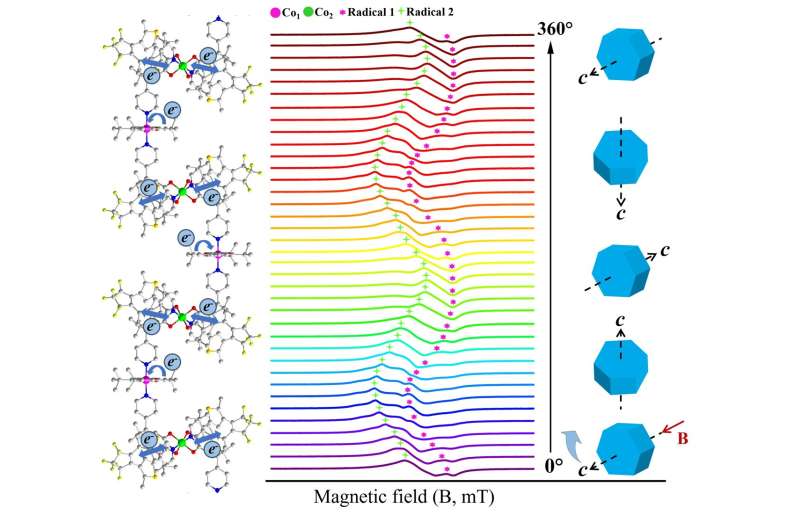This article has been reviewed according to Science X's editorial process and policies. Editors have highlighted the following attributes while ensuring the content's credibility:
fact-checked
trusted source
proofread
Dual-radical observation in a photoswitchable coordination polymer with synergy effect of semi-conductivity

In a study published in the journal National Science Review and led by Dr. Zhao-Yang Li (School of Material Science and Engineering, Nankai University) and Prof. Masahiro Yamashita (Department of Chemistry, Graduate School of Science, Tohoku University), a photoisomerizable ligand was used to synthesize two VT coordination polymers, which display VT and photoconversion behavior.
Two crystallographically independent SQ·– radicals arranged along the 1D chain were observed in the open-form complex using SC-XRD. Therefore, two clearly distinct radical signals were observed in the high-field/-frequency single-crystal EPR spectra of a VT complex for the first time.
In their strategy, a pyridyl derivative of a diarylethene (DAE) ligand was used as the linker along with the Co-dioxolene unit, which is a classical VT building block, to form a VT CP with a chain structure. Light may promote the rearrangement of the crystal structure and further influence magnetic properties through modification of the ligand field (isomers differ substantially in shape and conjugation), leading to photocontrol and deep insight into organic radicals on a 1D chain.
An open-form and a closed-form complex were synthesized. Photoconversion between the open- and closed-form species (ligands and complexes) due to the effect of DAE ligand photoisomerization was explored through UV/vis absorption spectroscopy.
Notably, the 1D chains in the two types of complexes differ due to the open and closed forms of the 6F-DAE-py2 ligand. The open-form complex exhibits a zigzag 1D structure, while the closed-form complex displays quasi-linear characteristics. In the study of SC-XRD, two types of crystallographically distinct SQ·– radicals, referred to as Radical 1 and Radical 2, are observed in the chains of the open-form complex due to their zigzag configurations.
They used high-field (~13.3 T) and -frequency (~360 GHz) single-crystal EPR spectroscopy to significantly enhance the resolution of Zeeman splitting in the open-form complex, which led to the observation of a remarkable phenomenon. Dual SQ·– radical signals were directly visualized when the c-axis was aligned with the static field.
Furthermore, angle-dependent EPR spectroscopy was carried out. The directional variations of these dual radicals, as well as their 180° periods, were confirmed. To conveniently investigate the two directional radicals, they determined the face index of a single crystal of the open-form complex. In this way, they confirmed the gz value of Radical 1 and distinguished the g1 and g2 values obtained in high-field and high-frequency EPR spectroscopy.
Interestingly, a synergistic effect between valence tautomerism and semi-conductivity was found in magnetic and electronic studies. Electrical conductivity increased with increasing temperature below the transition temperature, which is a characteristic semiconductor behavior. However, electrical conductivity was observed to decrease with increasing temperature above 330 K, which is ascribable to electron transfer during valence tautomerism.
Such behavior was observed for the first time in a single-crystal VT complex. The Arrhenius analysis determined the origin of the semiconductive behavior before 330 K, while DFT calculations helped illustrate the mechanism of the unusual change in electrical conductivity during the VT transition process.
This study presents the first example of dual-radical-based molecular anisotropy and charge-transfer-induced conductive anisotropy in a photoswitchable coordination polymer. It is of considerable significance with regard to the anisotropy and synthesis of multifunctional bistable magnetic materials in the molecular magnetism field.
More information: Jing-Wei Dai et al, Dual-radical-based molecular anisotropy and synergy effect of semi-conductivity and valence tautomerization in a photoswitchable coordination polymer, National Science Review (2023). DOI: 10.1093/nsr/nwad047
Provided by Science China Press




















